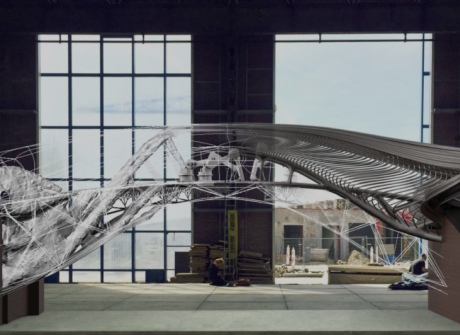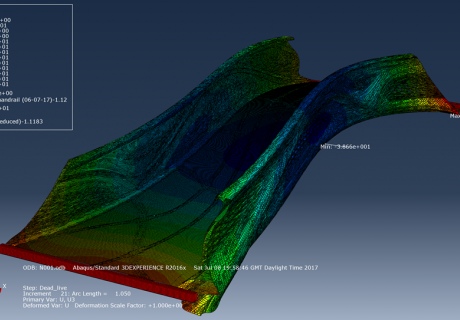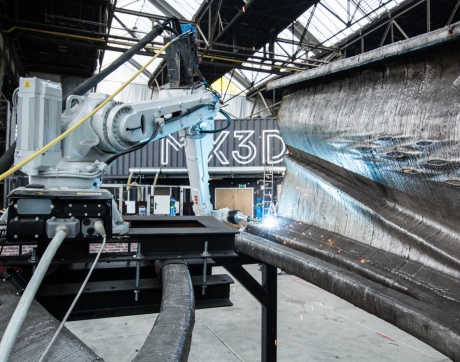
The bridge being printed. Image: Olivier de Gruijter

Imperial researchers are part of a team testing a 3D printed footbridge due to be installed across a canal in Amsterdam in 2018.
The team, led by the The Alan Turing Institute and 3D printing company MX3D, will measure, monitor and analyse the performance of the 12 metre-long stainless steel bridge, which will be the world’s largest 3D printed metal structure.
About a third of the bridge has already been printed in a lab in the Netherlands, and it is due to be installed in late 2018. It will cross the busy Oudezijds Achterburgwal canal in central Amsterdam, and will be open to pedestrians and cyclists.
A vast sensor network will be designed and installed on the bridge by a team of structural engineers, mathematicians, computer scientists and statisticians working in The Alan Turing Institute-Lloyd’s Register Foundation programme in data-centric engineering. The programme is led by Professor Mark Girolami, who is Chair in Statistics in the Department of Mathematics at Imperial College London.
The sensors will collect data on structural measurements such as strain, displacement and vibration and measure environmental factors such as air quality and temperature, enabling engineers to measure the bridge’s ‘health’ in real time and monitor how it changes over its lifespan.

The concept design and build of the bridge. Image: Joris Laarman Lab
Professor Girolami said: “The 3D printed bridge being installed by the MX3D team next year will be a world first in engineering. This data-centric, multidisciplinary approach to capturing the bridge’s data will also mark a step-change in the way bridges are designed, constructed, and managed, generating valuable insights for the next generation of bridges and other major public structures.
“It is a powerful embodiment of what data-centric engineering can deliver as a discipline, and I look forward to seeing the bridge in action from summer next year.”
The data from the sensors will be inputted into a ‘digital twin’ of the bridge: a living computer model developed by the Steel Structures group in the Department of Civil and Environmental Engineering at Imperial.

Predicted vertical deflections, under typical pedestrian load, from the digital twin model
The digital twin will imitate the physical bridge with growing accuracy in real time as data from the sensors comes in. The performance and behaviour of the physical bridge can be tested against its digital twin, which will provide valuable insights into designs for future 3D printed metallic structures. It will also enable the current 3D bridge to be modified to suit any required changes in use, ensuring it is safe and secure for pedestrians.
Members of the Steel Structures group, led by Professor Leroy Gardner, are currently testing samples of the 3D printed steel, to anticipate the behaviour of the bridge under loading from pedestrian or cycling traffic and inform its design.
Professor Gardner said: “3D printing presents tremendous opportunities to the construction industry, enabling far greater freedom in terms of material properties and structural geometries, but this freedom also brings a range of challenges and will require a new way of thinking for structural engineers.”
The Centre for Smart Infrastructure and Construction at Cambridge, led by Dr Mohammed Elshafie, are working with Imperial on the design and installation of the sensor network. Other partners on the project include software engineers Autodesk and The Amsterdam Institute for Advanced Metropolitan Solutions, who will explore new ways to use and connect the bridge data with other data streams in the city. The build of the bridge is supported by the Lloyd’s Register Foundation.

MX3D's robot printing the bridge. Image: Olivier de Gruijter
Gijs van der Velden, COO of MX3D, said: “The 3D structure being built by MX3D offers engineers the freedom of working with an entirely new material. The digital twin of the bridge will see the development of a new design language and we hope it will be a significant step in the introduction of this exciting new form of structure into the construction market.”
The data captured from the bridge will be made open for research, and MX3D have launched an open call (closing February 2018) seeking creative and innovative ideas that will make use of the collected data.
Article text (excluding photos or graphics) available under an Attribution-NonCommercial-ShareAlike Creative Commons license.
Photos and graphics subject to third party copyright used with permission or © Imperial College London.
Reporter
Hayley Dunning
Communications Division

Contact details
Tel: +44 (0)20 7594 2412
Email: h.dunning@imperial.ac.uk
Show all stories by this author
Leave a comment
Your comment may be published, displaying your name as you provide it, unless you request otherwise. Your contact details will never be published.





Comments
Comments are loading...